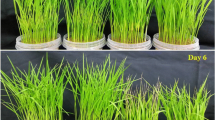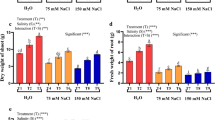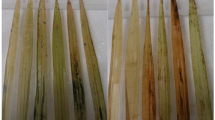Abstract
In the present study, we investigated the salt tolerance mechanism of two rice cultivars (Zhenghan-2 and Yujing-6), which show different tolerance to drought and disease. NaCl induced higher extent of lipid peroxide and ion leakage in Yujing-6 roots than those in Zhenghan-2 roots. H2O2 accumulation in Zhenghan-2 roots was lower than that in Yujing-6 roots under salt stress. Comparatively, NaCl treatment did not increase O2 − contents in both rice roots, however, O2 − level in Yujing-6 roots was higher than that in Zhenghan-2 roots under both control and salt stress conditions. Ascorbate peroxidases (APX) activity increased more significantly in Zhenghan-2 roots than that in Yujing-6 roots. The activity of catalase (CAT), peroxidase (POD), superoxide dismutase (SOD), and glucose-6-phosphate dehydrogenase (G6PDH) was similarly enhanced in both rice roots under salt stress; however, they showed higher levels in Zhenghan-2 roots than in Yujing-6 roots. Exogenous H2O2 could enhance APX, CAT, POD, SOD and G6PDH activities in a concentration-dependent manner in both rice roots. Diphenylene iodonium (DPI), a plasma membrane (PM) NADPH oxidase inhibitor, which counteracted the NaCl-induced H2O2 accumulation, markedly decreased the activity of above enzymes. Moreover, ion leakage increased dramatically in Zhenghan-2 roots and reached to the similar level of Yujing-6 roots under NaCl+DPI treatment. Taken together, H2O2, which is mainly generated from PM NADPH oxidase, is involved in Zhenghan-2 rice tolerance to salt stress by enhancing the cellular antioxidant level.






Similar content being viewed by others
Abbreviations
- APX:
-
Ascorbate peroxidases
- CAT:
-
Catalases
- DPI:
-
Diphenylene iodonium
- G6PDH:
-
Glucose-6-phosphate dehydrogenase
- GR:
-
Glutathione reductase
- H2O2 :
-
Hydrogen peroxide
- O2 − :
-
Superoxide anion radical
- OH· :
-
Hydroxyl radical
- PM:
-
Plasma membrane
- POD:
-
Peroxidases
- ROS:
-
Reactive oxygen species
- SOD:
-
Superoxide dismutases
- TBARS:
-
TBA-reactive substances
References
Apel K, Hirt H (2004) Reactive oxygen species: metabolism, oxidative stress, and signal transduction. Annu Rev Plant Biol 55:373–399
Bartosz G (1997) Oxidative stress in plants. Acta Physiol Plant 19:47–64
Bradford MM (1976) A rapid and sensitive method for the quantitation of microgram quantities of protein utilizing the principle of protein-dye binding. Anal Biochem 72:248–254
Bright J, Desikan R, Hancock JT, Weir IS, Neill SJ (2006) ABA-induced NO generation and stomatal closure in Arabidopsis are dependent on H2O2 synthesis. Plant J 45:113–122
Davletova S, Rizhsky L, liang H, Shengqiang Z, Oliver DJ, Coutu J et al (2005) Cytosolic ascorbate peroxidase 1 is a central component of the reactive oxygen gene network of Arabidopsis. Plant Cell 17:268–281
Durner J, Klessing DF (1996) Salicylic acid is a modulator of tobacco and mammalian catalases. J Biol Chem 271:28492–28502
Dutilleul C, Garmier M, Noctor G, Mathieu C, Chétrit P, Foyer CH, de Paepe R (2003) Leaf mitochondria modulate whole cell redox homeostasis, set antioxidant capacity, and determine stress resistance through altered signaling and diurnal regulation. Plant Cell 15:1212–1226
Elstner EF, Heupel A (1976) Inhibition of nitrite formation from hydroxylammonium chloride: a simple assay for superoxide dismutase. Anal Biochem 70:616–620
Esposito S, Carfagna S, Massaro G, Vona V, Di MRV (2001) Glucose-6-phosphate dehydrogenase in barley roots: kinetic properties and localization of the isoforms. Planta 212:627–634
Foyer CH, Halliwell B (1976) The presence of glutathione and glutathione reductase in chloroplasts: a proposed role in ascorbic acid metabolism. Planta 133:21–25
Foyer CH, Noctor G (2000) Oxygen processing in photosynthesis: regulation and signalling. New Phytol 146:359–388
Foyer CH, Noctor G (2005a) Redox homeostasis and antioxidant signaling: a metabolic interface between stress perception and physiological responses. Plant Cell 17:1866–1875
Foyer CH, Noctor G (2005b) Oxidant and antioxidant signaling in plants: a re-evaluation of the concept of oxidative stress in a physiological context. Plant, Cell Environ 28:1056–1071
Fridovich I (1986) Biological effects of the superoxide radical. Arch Biochem Biophys 247:1–11
Fridovich I, Beauchamp C (1971) Superoxide dismutase improved assays and an assay applicable to acrylamide gels. Anal Biochem 44:276–287
Gong M, Chen B, Li ZG, Guo LH (2001) Heat-shock-induced cross adaptation to heat, chilling, drought and salt stress in maize seedlings and involvement of H202. J Plant Physiol 158:125–1130
Hammerschmidt R, Nuckles EM, Kuc J (1982) Association of enhanced peroxidase activity with induced systemic resistance of cucumber to colletotrchum lagenarium. Physiol Plant Pathol 20:73–82
Hasegawa PM, Bressan RA, Zhu JK, Bohnert HJ (2000) Plant cellular and molecular responses to high salinity. Annu Rev Plant Physiol Plant Mol Biol 51:463–499
Heath RL, Packer L (1968) Photoperoxidation in isolated chloroplasts. I. Kinetics and stoichiometry of fatty acid peroxidation. Arch Biochem Biophys 125:189–198
Hernández JA, Olmos E, Corpas FJ, Sevilla F, del Río LA (1995) Salt-induced oxidative stress in chloroplasts of pea plants. Plant Sci 105:151–167
Hernández JA, Ferrer MA, Jiménez A, Barceló AR, Sevilla F (2001) Antioxidant systems and O2 −/H2O2 production in the apoplast of pea leaves. Its relation with salt-induced necrotic lesions in minor veins. Plant Physiol 127:817–831
Heyser JW, Nabors MW (1981) Osmotic adjustment of cultured tobacco cells (Nicotiana tabacum var. Samsun) grown on sodium chloride. Plant Physiol 67:720–727
Huang CH, He WL, Guo JK, Chang XX, Su PX, Zhang LX (2005) Increased sensitivity to salt stress in an ascorbate-deficient Arabidopsis mutant. J Exp Bot 56:3041–3049
Li JS, Chen GC, Wang XM, Zhang YL, Jia HL, Bi YR (2010) Glucose-6-phosphate dehydrogenase-dependent hydrogen peroxide production is involved in the regulation of plasma membrane H+-ATPase and Na+/H+ antiporter protein in salt-stressed callus from Carex moorcroftii. Physiol Plant 141(3):239–250
Li JS, Wang XM, Zhang YL, Jia HL, Bi YR (2011) cGMP regulates hydrogen peroxide accumulation in calcium-dependent salt resistance pathway in Arabidopsis thaliana roots. Planta 234(4):709–722
Liu YG, Wu RR, Wan Q, Xie GQ, Bi YR (2007) Glucose-6-phosphate dehydrogenase plays a pivotal role in nitric oxide-involved defense against oxidative stress under salt stress in red kidney bean roots. Plant Cell Physiol 48:511–522
Marino D, Gonzalez EM, Frendo P, Puppo A, Arrese-Igor C (2007) NADPH recycling systems in oxidative stressed pea nodules: a key role for the NADP+-dependent isocitrate dehydrogenase. Planta 225:413–421
Mittler R, Vanderauwera S, Gollery M, Van Breusegem F (2004) The reactive oxygen gene network of plants. Trends Plant Sci 9:490–498
Nakano Y, Asada K (1981) Hydrogen peroxide is scavenged by ascorbate-specific peroxidase in spinach chloroplasts. Plant Cell Physiol 22:867–880
Neill SJ, Desikan R, Clarke A, Hurst RD, Hancock JT (2002) Hydrogen peroxide and nitric oxide as signaling molecules in plants. J Exp Bot 53:1237–1242
Noctor G, Foyer CH (1998) Ascorbate and glutathione: keeping active oxygen under control. Annu Rev Plant Physiol Plant Mol Biol 49:249–279
Noctor G, Arisi A-CM, Jouanin L, Kunert K-J, Rennenberg H, Foyer CH (1998) Glutathione: biosynthesis, metabolism and relationship to stress tolerance explored in transformed plants. J Exp Bot 49:623–647
Pandolfi PP, Sonati F, Riv RI, Mason P, Grosveld F, Luzzatto L (1995) Targeted disruption of the housekeeping gene encoding glucose 6-phosphate dehydrogenase (G6PD): G6PD is dispensable for pentose synthesis but essential for defense against oxidative stress. EMBO J 14:5209–5215
Pastori GM, Foyer H (2002) Common components, networks and pathways of cross-tolerance to stress. The central role of ‘redox’ and abscisic acid-mediated controls. Plant Physiol 129:460–468
Polidoros A, Scandalios J (1999) Role of hydrogen peroxide and different classes of antioxidants in the regulation of catalase and glutathione-S-transferase gene expression in maize (Zea mays L.). Physiol Plant 106:112–120
Pugin A, Frachisse JM, Tavernier E, Bligny R, Gout E, Douce R, Guern J (1997) Early events induced by the elicitor cryptogein in tobacco cells: involvement of a plasma membrane NADPH oxidase and activation of glycolysis and the pentose phosphate pathway. Plant Cell 9:2077–2091
Sairam RK, Srivastava GC (2002) Changes in antioxidant activity in subcellular fraction of tolerant and susceptible wheat genotypes in response to long term salt stress. Plant Sci 162:897–904
Salvemini F, Franze A, Iervolino A, Filosa S, Salzano S, Ursini MV (1999) Enhanced glutathione levels and oxidoresistance mediated by Increased glucose-6-phosphate dehydrogenase expression. J Biol Chem 274:2750–2757
Scandalios JG (1993) Oxygen stress and superoxide dismutases. Plant Physiol 101:7–12
Shang QM, Li XF, Zhang ZG (2007) Molecular mechanisms of cross adaptation in plants. Acta Bot Boreal-Occident Sin 27(9):1921–1928
Simon-Plas F, Elmayan T, Blein JP (2002) The plasma membrane oxidase NtrbohD is responsible for AOS production in elicited tobacco cells. Plant J 31:137–147
Tian WN, Braunstein LD, Pang J, Stuhlmeier KM, Xi QC, Tian X, Stanton RC (1998) Importance of glucose-6-phosphate dehydrogenase activity for cell growth. J Biol Chem 273:10609–10617
Ursini MV, Parrella A, Rosa G, Salzano S, Martini G (1997) Enhanced expression of glucose-6-phosphate dehydrogenase in human cells sustaining oxidative stress. Biochem J 323:801–806
Veljovic-Jovanovic SD, Noctor G, Foyer CH (2002) Are leaf hydrogen peroxide concentrations commonly overestimated? The potential influence of artefactual interference by tissue phenolics and ascorbate. Plant Physiol Biochem 40:501–507
Vittoria L, Maria CP, Laura DG (2009) Different involvement of the mitochondrial, plastidial and cytosolic ascorbate-glutathione redox enzymes in heat shock responses. Physiol Plant 135:296–306
Wang SX, Yin HQ, Tang BJ, Wang YT, Chen SF (2003a) Zhenghan-2: a new variety of rice with high yield and the tolerance to drought stress. China Seed Industry 10:64
Wang SX, Yin HQ, Tang BJ, Wang YT, Huang L (2003b) The selection of Zhenghan-2, a new variety of rice with high yield and the tolerance to drought stress. Crops 5:51–52
Wang XM, Ma YY, Huang CH, Wan Q, Li N, Bi YR (2008a) Glucose-6-phosphate dehydrogenase plays a central role in modulating reduced glutathione levels in reed callus under salt stress. Planta 227:611–623
Wang XM, Ma YY, Huang CH, Li JS, Wan Q, Bi YR (2008b) Involvement of glucose-6-phosphate dehydrogenase in reduced glutathione maintenance and hydrogen peroxide signal under salt stress. Plant Signal Behav 3(6):394–395
Wang HH, Liang XL, Huang JJ, Zhang DK, Lu HX, Liu ZJ, Bi YR (2010) Involvement of ethylene and hydrogen peroxide in induction of alternative respiratory pathway in salt-treated Arabidopsis calluses. Plant Cell Physiol 51:1754–1765
Yang YL, Zhang F, He WL, Wang XM, Zhang LX (2003) Iron-mediated inhibition of H+-ATPase in plasma membrane vesicles isolated from wheat roots. Cell Mol Life Sci 60:1249–1257
Yu LJ, Lan WZ, Chen C, Yang Y (2004) Glutathione levels control glucose-6-phosphate dehydrogenase activity during elicitor-induced oxidative stress in cell suspension cultures of Taxus chinensis. Plant Sci 167:329–335
Zhang F, Guo JK, Yang YL, He WL, Zhang LX (2004) Changes in the pattern of antioxidant enzymes in wheat exposed to water deficit and rewatering. Acta Physiol Plant 26:345–352
Zhang ZY, Wang HH, Wang XM, Bi YR (2011) Nitric oxide enhances aluminum tolerance by affecting cell wall polysaccharides in rice roots. Plant Cell Rep 30(9):1701–1711
Zhao LQ, Zhang F, Guo JK, Yang YL, Li BB, Zhang LX (2004) Nitric oxide functions as a signal in salt resistance in the calli from two ecotypes of reed. Plant Physiol 134:849–857
Zhao L, He JX, Wang XM, Zhang LX (2008) Nitric oxide protects against polyethylene glycol-induced oxidative damage in two ecotypes of reed suspension cultures. J Plant Physiol 165:182–191
Acknowledgments
This study was supported by the National Natural Science Foundation of China (31170225; 31201145), the National High Technology Research and Development Program (2007AA021401), Foundation of Science and Technology Program of Gansu Province (1107RJYA005), Fundamental Research Funds for the Central Universities (lzujbky-2012-104) and Chunhuijihua Foundation (Z2008-1-62015).
Author information
Authors and Affiliations
Corresponding author
Additional information
Communicated by G. Bartosz.
Rights and permissions
About this article
Cite this article
Wang, X., Hou, C., Liu, J. et al. Hydrogen peroxide is involved in the regulation of rice (Oryza sativa L.) tolerance to salt stress. Acta Physiol Plant 35, 891–900 (2013). https://doi.org/10.1007/s11738-012-1132-6
Received:
Revised:
Accepted:
Published:
Issue Date:
DOI: https://doi.org/10.1007/s11738-012-1132-6




